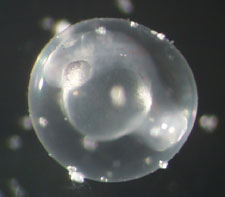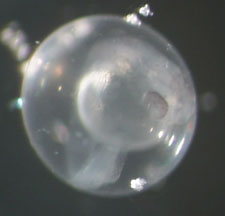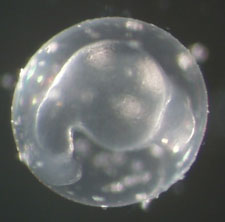|
|

|
|
|
Results &
Conclusions:
The zebrafish in the control group developed normally as
was expected. At the stage that they were observed, they
showed normal eye development. (figure 2). The embryos in
the 1% ethanol solution also showed normal development in
the region of the head (figure 3). Apparenty this
concentration of ethanol was not sufficient to cause
cyclopia.
The 2.5% ethanol experimental group showed a limited number
of deformed embryos. Out of the ten original embryos two
failed to survive, though this was consistent with the
survival rate of the control group. Out of the eight that
survived, six developed normally and two were slightly
deformed. It appears that under these experimental
conditions a higher concentration of ethanol was needed to
produce a higher frequency of teratogenic results. It was
difficult to determine whether the two deformed emrbyos had
full blown cyclopia but they did not have visible eyes
(figure 4).

Figure 2: An embryo from the control group, eye pigment can
be clearly seen.

Figure 3: Embryo from the 1% ethanol group showing normal
eye development.

Figure 4: Embryo from 2.5% ethanol group showing
underdeveloped or absent eyes.
|
|